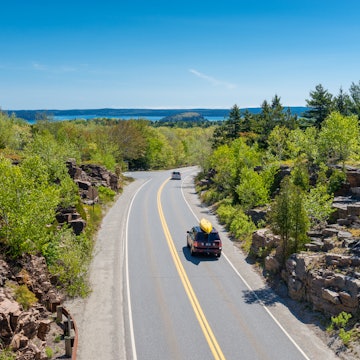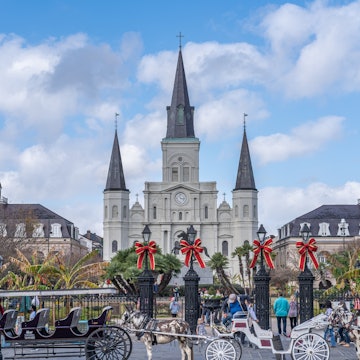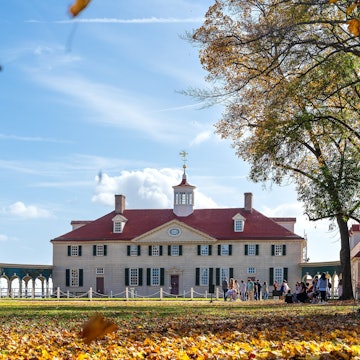
9 places in the South that bring the Civil Rights Movement to life

Jan 17, 2025 • 7 min read

At these historic sites and memorials throughout the South, you can trace the tragedies and triumphs of the Civil Rights Movement. Carlos Avila Gonzalez/San Francisco Chronicle via Getty Images
A momentous chapter in the history of the USA, the Civil Rights Movement is more than one contained narrative. Instead, it unfolded as a series of episodes – and continues to unfold to this day.
Some of the movement’s most important moments, from the beautiful (marchers moving forward, hand in hand, in Selma, Alabama) to the nightmarish (those same marchers set on by police dogs) took place on Southern soil – and are etched into the South’s soul.
With Black History Month around the corner, and as we prepare to honor the contributions and sacrifices made by African Americans, here are some of the most moving and evocative sites where history was made.

1. Get close to tragedy in Birmingham, Alabama
The Alabama cities of Birmingham, Montgomery and Selma form a triangle that traces the most important geography of the Civil Rights Movement in the 1960s – and today make up the Alabama Civil Rights Trail.
Few locales better testify to the agonies – and achievements – of civil rights than the Birmingham Civil Rights Institute, located across the street from 16th Street Baptist Church, where four young Black girls were killed when the church was bombed in 1963. Thoughtful exhibits keep visitors engaged as they move through this enormous, deep and enlightening museum.
A poignant urban walk, Birmingham’s Civil Rights Memorial Trail encompasses seven blocks and features historical markers and powerful sculptures depicting important moments from the 1950s and 1960s era of the movement. Of particular note, both along this trail and at the Birmingham Civil Rights Institute, are the reactions and intellectual justifications given by those who opposed civil rights (which are sadly familiar even in this day). As this trail and different museums show, many carried signs supporting “states’ rights” (to segregate), “law and order” and their right to protect “Southern heritage.”

2. Contemplate Rosa Parks’ legacy in Montgomery
At Montgomery’s Rosa Parks Museum, visitors can learn that it was the action of Parks, a trained activist who refused to move to the back of the bus one day in 1955, set in motion the Montgomery bus boycott, a carefully prepared and brilliantly executed campaign of civil disobedience. Just a few blocks away, the Legacy Museum artfully explains the roots of institutionalized racism in the USA and, bringing the story to the present, continues to persist in the 21st century.
Nearby, you can visit a small house that once served as the home and workspace of a young pastor named Dr Martin Luther King Jr, who lived here as he and others organized the Montgomery bus boycotts. Inside Dexter Avenue Parsonage, you’ll see both reproductions and actual examples of the King family’s library (including books on nonviolent resistance), old vinyl records, ashtrays, and mid-century furniture and accoutrements. Guides will also point out the spot on the front porch where white supremacists tried to bomb the King family. Travelers may also want to stop by the actual Dexter Avenue King Memorial Church, which is famously welcoming to curious visitors.
A smooth circle of black granite covered in a skin of rushing water makes a poignant memorial to 40 martyrs of the movement at the Civil Rights Memorial Center. Designed by Maya Lin (who also designed the Vietnam Veterans Memorial in DC), the monument marks the entrance to a small museum that details the lives lost in both the American Civil Rights Movement and struggles for justice and equality from around the world. A new, powerful and must-visit addition to Montgomery’s scene is the National Memorial for Peace and Justice, which movingly commemorates the country’s many victims of lynching.

3. Follow in the footsteps of giants across the Edmund Pettus Bridge
Some 50 miles to the west, in Selma, the Edmund Pettus Bridge is the site of one of the movement’s most searing episodes. In March 1965, a coalition of nonviolent protesters began a march to Montgomery by crossing the bridge – only to be set upon by bigots waving Confederate flags and police accompanied by attack dogs in the infamous episode that came to be known as “Bloody Sunday.” (On their third try, the marchers at last completed their long walk to Montgomery.) Today, the bridge sits near the National Voting Rights Museum and is, for many tourists, the culmination of the Alabama Civil Rights Trail.
4. Remember Emmett Till in Mississippi
In 1955, 14-year-old Emmett Till was murdered after he was accused of flirting with a white woman. (His accuser would later recant her testimony.) His killers, who openly bragged about the murder, were soon acquitted by an all-white, all-male jury – yet the subsequent media firestorm brought the issue of extrajudicial violence against African Americans into the public consciousness. Located in the Mississippi courthouse where the Till trial was argued, the Emmett Till Museum offers an interactive – and wrenching – storytelling experience. Sadly, signs memorializing Till and marking the spot where his body was recovered from the Mississippi River are frequently riddled with bullets or otherwise defaced.

5. Honor Dr King and other leaders in Atlanta
Georgia was also a hub in the fight against segregation, and Atlanta is one of the best places to explore this history. The excellent Center for Civil and Human Rights has an exhaustive collection of materials and interpretive exhibits that focus on the 1950s and ’60s phases of the American Civil Rights Movement. Video footage of iconic moments like street protests and justice marches, plus re-creations of segregated spaces, deliver an experience of immediacy and visceral power.
The multi-block Martin Luther King Jr National Historic Site includes Dr King’s birthplace (which only accepts a limited amount of visitors per day), and a visitor center that provides an in-depth grounding on the life of Dr King alongside a timeline of the early and mid-20th century civil rights–related events. If you plan your visit for a Sunday, you can attend services at the new branch of the Ebenezer Baptist Church, just a short walk from the visitor center. Once led by Dr King, the congregation is welcoming to visitors – but do make an effort to dress up for services.
6. Learn about the Little Rock Nine in Arkansas
Still actively educating youth, Little Rock Central High School is also a National Parks historic site thanks to its history. In 1957, nine African American students entered the school, facing down threats, taunts and a jeering mob – and setting into motion an era of desegregation in motion.
Like many of this era, the story of Little Rock Nine does not have a neat ending. Thanks to dodgy school zoning and the opening of “segregation academies” – private schools founded by white parents who wanted to avoid integrated public schools – many Southern school systems remain almost as segregated now as they were in the 1950s. Exhibits at the visitor center chart the history of the desegregation of the school system in Little Rock and Arkansas, as well as the broader South.

7. Learn about the loss of a great leader in Memphis
The National Civil Rights Museum in Memphis has a notable facade: that of the Lorraine Motel, a low-slung turquoise building where Dr Martin Luther King was assassinated by James Earl Ray in 1968. Two motel rooms have been preserved to mark the incident, a sort of shrine to a great man whom we lost too soon – just a small part of this sprawling museum.
A sequence of informative galleries traces the long arc of Black oppression in America, from slavery to segregation to the Black Power movement. Across the street is the preserved boardinghouse from which James Earl Ray fired the shots.

8. Explore a historic African American neighborhood in New Orleans
New Orleans’ Treme is the oldest African American neighborhood in the US and a charming place for a long, leisurely stroll. You’ll find the usual New Orleans architectural tableau of shotgun houses painted like a pastel rainbow, and colorful characters out for a walk. But don’t lose sight of history: the district neighborhood once housed free people of color, and later formerly enslaved people. When the free people built St Augustine Church, they made sure to purchase pews for their enslaved brothers and sisters. To this day, a cross formed from chains – representing faith in the face of slavery – testifies to this rich history.

9. Hear the revealing truth about the plantation lifestyle in Edgard, Louisiana
Many preserved plantations dot the South – yet the Whitney Plantation is the only one dedicated to telling the full story of the enslaved people who lived and toiled on them. A harrowing guided tour takes visitors through exhibits that demonstrate, with an unflinching eye, the cruelty and horror of Southern chattel slavery. It’s a powerful experience and serves as a necessary reminder that the often romanticized Southern way of life defended by the Confederacy (and later apologists) was inextricably wrapped up with slavery.















